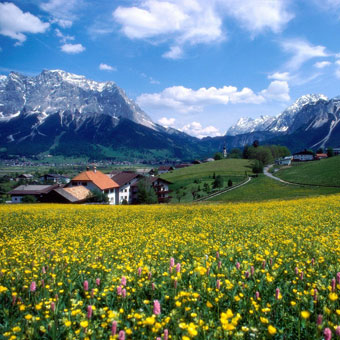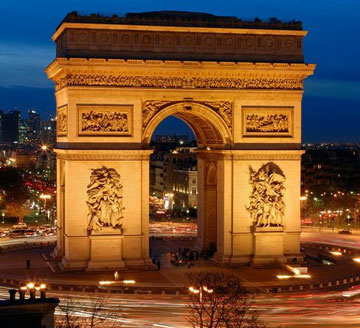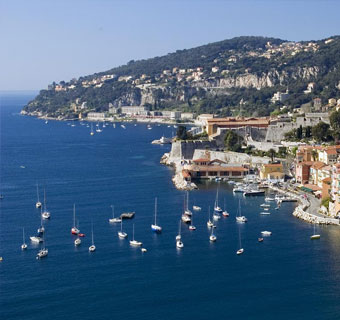France
Country statistics

Land area: 210,668 sq miles (545,630 sq km)
Total area: 211,209 sq miles (547,030 sq km)
Population (2010 est.): 64,057,792 (growth rate: 0.5%); birth rate: 12.4/1000; infant mortality rate: 3.3/1000; life expectancy: 81.1; density per sq km: 100
Capital City: Paris
Monetary unit: Euro (formerly French franc)
Languages: French 100%, rapidly declining regional dialects (Provençal, Breton, Alsatian, Corsican, Catalan, Basque, Flemish)
Ethnicity/race: Celtic and Latin with Teutonic, Slavic, North African, South-east Asian, and Basque minorities
Religions: Roman Catholic 83%-88%, Protestant 2%, Islam 5%-10%, Jewish 1%
Country introduction

France is bordered by Belgium, Luxembourg, Germany, Switzerland, Italy, Monaco, Andorra, and Spain. In some of its overseas parts, France also shares land borders with Brazil, Suriname, and the Netherlands Antilles. France is also linked to the United Kingdom via the Channel Tunnel, which passes underneath the English Channel.
Two thirds of France is mountains and hills, with the Alps, Pyrenees and Vosges ranges. Mont Blanc in the Alps is the highest mountain in Europe.
Paris is one of the world's most interesting cities with its broad range of attractions and cuisine experiences. It is a popular tourist area. Paris was founded by, and named after, the Celtic tribe, the Parisii. The cities of Lyon and Marseille also have their own spectacular, and truly unique character.
Outside of the main three cities, the rural areas offer a broad and diverse range of dramatic scenery and village life. Offering everything from rugged Alpine mountains in the south-east and romantic sea cliffs on the Atlantic coast, countless enchanting beaches in the west and south as well as, some of Europe's wildest areas, such as the wild Camargue in the south. The Mediterranean coast includes the popular tourist area, the French Riviera. Its hot, dry summers and mild winters make it a popular beach area.
The culture

The culture of France is diverse, reflecting regional differences as well as the influence of recent immigration. France has played an important role for centuries as a cultural center, with Paris as a world center of high culture.
France is noted for its cosmopolitan, civilized approach to life, combined with great concern for style, fashion and appearances. French people are sometimes perceived as taking a great pride in the national identity and positive achievements of France, although many French people would argue that people of all nations tend to do that.
The culture of France is diverse, reflecting regional differences as well as the influence of recent immigration. France has played an important role for centuries as a cultural center, with Paris as a world center of high culture.
Attractions & landmarks

Famous for its wines and cheeses, France is the world's most popular tourist destination receiving 82 million foreign tourists every year.
The most visited city in the world is the French capital, Paris. It is said to be the city of lovers and the most romantic place on earth. Without a doubt Paris is home to the global cultural icon of France and and one of the most recognizable structures in the world, the Eiffel Tower. It was unveiled as the entrance arch to the 1889 World's Fair and stands at 320 m (1,050 ft) high. The Cathedral of Notre Dame is also a national landmark in Paris, which was built in 1163. The cathedral is the largest church in Northern France and is notable for getting worldwide recognition in the popular book "The Hunchback of Notre Dame" by Victor Hugo. Another Paris attraction include The Louvre, one of the world's best known, and finest art galleries. It contains many of the world's most famous art, including the Mona Lisa (see Leonardo da Vinci). The Arc de Triomphe is also a Paris landmark and is the entrance way to the Champs Elysees.
Bordeaux is famous for its wine but is also a bustling city with lots of historic sights to discover. Lyon, the country's second largest city, boasts a beautiful old centre as well as a number of Roman ruins. Strasbourg, one of the EU headquarters, has a character of its own, with clear German influences. Montpellier is one of the best places in the south, with lots of monumental buildings and nice cafés. In the west there's the beautiful historic city of Nantes, home to the Château des ducs de Bretagne and many other monuments.

There are the magnificent cities of the Côte d'Azur, once the place to be for the rich and famous but now equally popular with a general crowd. Its sandy beaches, beautiful bays, rocky cliffs and lovely towns has made it one of the main yachting and cruising areas in the world as well as popular destination for land-bound travellers. There's the bustling city of Nice, where some 4 million tourists a year enjoy the stony beaches and stroll over the Promenade des Anglais. Avignon with its splendid ramparts and Palais-des-Papes was once the seat of popes. Although Saint-Tropez gets overcrowded in summer, it's a delightful place in any other season. The same goes for Cannes, where the jet-set of the film industry gathers each year for the famous Cannes Film Festival. From there, a boat trip can be taken to the much more peaceful Îles de Lérins.
France has many amazing countrysides that are dotted with wonderful medieval villages and castles. The country's landscapes vary from the snow-covered peaks of the Alps and the Pyrenees with their many winter sports resorts to lush river valleys, dense forests and huge stretches of farmland and vineyards. The Provence, backing a good part of the Côte d'Azur, is one of the most beloved regions. It has a typical Mediterranean atmosphere and is famous for its lavender fields and rosé wines. It's also home to the stunning Verdon Gorge, one of the most beautiful gorges in Europe. The rolling riverine landscape of the Loire Valley is home to many great castles, of which Châteaux Amboise, Château de Villandry, Azay-le-Rideau, Chambord and Châteaux du Pin are some of the finest examples. The western region of Brittany reaches far into the Atlantic and boasts many megalith monuments such as those near Carnac. The beaches of Normandy, also on the Atlantic coast, are famed for the D-Day Allied invasion on June 6, 1944 (see World War II). Its picturesque coast line includes both long stretches of beach and steep limestone cliffs, such as those near Étretat). The region is also home to the splendid and World Heritage listed Mont-Saint-Michel and its Bay. The lush hills of the Dordogne form another region famous for its castles, with over 1500 of them.